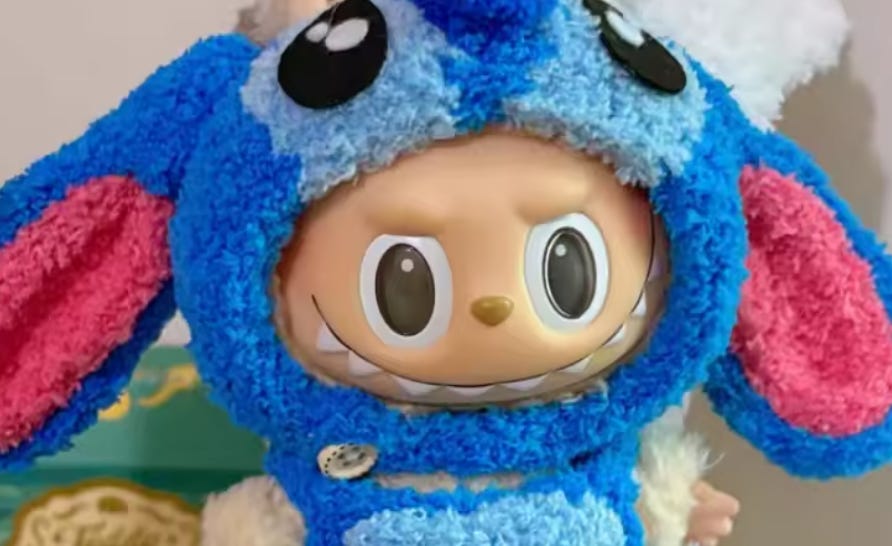
Who Makes Labubu?
Labubu isn’t the product of a major corporate giant but rather the creation of Hong Kong-based artist Kasing Lung. He first introduced the character in 2015 as part of his children’s book series The Monsters. Inspired by Nordic folklore, Labubu is a whimsical creature with elf-like features, pointy ears, and a mischievous grin. Lung, who splits his time between Hong Kong and the Netherlands, never intended for his work to become a global phenomenon.
In 2019, Pop Mart, a leading Chinese toy company, licensed Lung’s designs and transformed Labubu into a blind box sensation. The blind box model involves mystery packs where buyers can only see what they get after purchasing. This format has proven wildly successful, with Labubu plushies ranging from basic keychains to limited-edition versions that can sell for hundreds or even thousands of dollars on resale platforms.
By August 2025, Pop Mart had over 500 stores worldwide, with vending machines dispensing Labubu toys like candy. The company’s strategy of scarcity and exclusivity has attracted Gen Z collectors, turning a $9 blind box into a highly sought-after item.
Despite its popularity, Labubu is not connected to Disney. The brand remains independent, with Kasing Lung still involved in new releases. However, the confusion is understandable given Disney’s massive influence on global merchandising.
Is There Any Real Disney Connection to Labubu?
No, Disney does not own, produce, or license Labubu. The character is entirely the product of Kasing Lung and Pop Mart. However, there are some interesting parallels between the two brands.
Pop Mart has collaborated with Disney on various blind box lines since 2020, such as the DIMOO WORLD × DISNEY series, which features vinyl plush keychains of characters like Mickey Mouse and Winnie the Pooh. These items share similarities with Labubu in terms of style and collectibility, though they are distinct from the Labubu line itself.
In 2025, Disney Japan launched Urupocha-chan, a line of palm-sized plush bag charms inspired by characters like Pooh and Stitch. These toys mimic Labubu’s “ugly-cute” aesthetic and are sold in blind bags, further blurring the lines between the two brands.
Analysts suggest that Disney’s move was a strategic attempt to capture the Labubu craze, especially in Asia, where Pop Mart dominates the market. The Urupocha-chan line sold out quickly online, showing how effectively Disney can tap into emerging trends.
Interestingly, Labubu has even faced some pushback at Disney parks. In July 2025, reports emerged that cast members at Disneyland Paris and Hong Kong Disneyland asked guests to remove Labubu plushies, citing safety concerns or IP issues. While no official ban was announced, the incident highlighted how Labubu’s popularity has begun to encroach on Disney’s territory.
How Labubu Stacks Up to Disney’s Similar Lines
Disney has long been a leader in collectible merchandise, and its approach to blind boxes and overseas exclusives mirrors the Labubu phenomenon in many ways.
In the U.S., Disney offers products like Disney Doorables, which are mini figures sold in mystery packs starting at around $5. These items share the surprise element of Labubu, with themes ranging from Pixar to Marvel.
Overseas, the similarity is even more pronounced. In Hong Kong, Disney offers exclusive keychains and plush charms that are often sold in blind bags. In Japan, Disney Stores drop limited plush pendants like Tsum Tsum or character-inspired blobs, blending kawaii aesthetics with collectibility.
In China, where Pop Mart holds significant market power, Disney partners with local companies to create blind boxes featuring popular IPs like Frozen and The Lion King. These items are priced between $10 and $20, making them accessible to budget-conscious buyers.
Pop Mart also collaborates with Disney on other lines, such as the Skullpanda and Molly series, which mix spooky-cute aesthetics with Disney characters. These collaborations highlight how both brands have embraced the blind box trend, further fueling the confusion between them.
Why the Disney Mix-Up Persists in 2025
The confusion between Disney and Labubu stems from several factors. Both brands use similar merchandising strategies, including blind boxes, collectible charm-style items, and a focus on affordability. Additionally, the rise of knockoffs and counterfeit products has blurred the lines between legitimate and fake items.
Pop Mart’s success with Labubu, which generated $418 million in revenue during the first half of 2025, has put pressure on Disney to compete. The company has expanded its blind box offerings in the Asia-Pacific region, mirroring Pop Mart’s model. This has led to speculation that Disney might be behind Labubu, although insiders confirm this is not the case.
Another factor is the cultural impact of Labubu. Celebrities like Lisa and Rihanna have been spotted with Labubu plushies, increasing its visibility. At the same time, reports of real Labubus being stolen from U.S. stores have fueled rumors about potential Disney collaborations.
Environmental concerns also play a role. Both brands use plastics in their products, sparking debates about sustainability. Despite these challenges, the overlap between Disney and Labubu continues to generate buzz, keeping the conversation alive.
